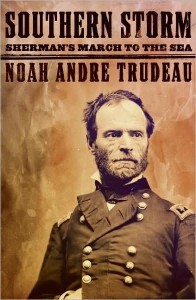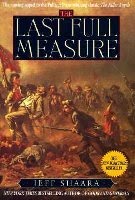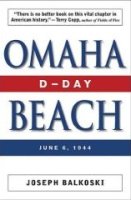
“Southern Storm: Sherman's March to the Sea” by Noah Andre Trudeau provides a skilled account of one of the US Civil War’s most notorious campaigns. Mr. Trudeau chronicles the daily grind of a 60,000 man Union army harvesting a three hundred mile path of scavenging, fire, and devastation from Atlanta to Savannah. Every day of the campaign is different and uniquely described without repetition. The story is told for the most part from the side of the Union army. I wondered how Mr. Trudeau would avoid boredom in a story that has no major battles. He did brilliant job of avoiding dullness and monotony.
The author makes it clear that Sherman worked hard avoiding major confrontation with the Confederate forces. Sherman divided his force into two parts to terrorize the greatest number of objectives and to avoid encountering concentrated Southern defenses. The General was hugely successful in this area, not only because of his own efforts, but with a great deal of help from the South and its failure to form a unified command structure to oppose him.
Noah Andre Trudeau does a good job explaining how Hood took his sizeable forces and went north to threaten northern supply lines. Hood’s motivation was in all probability to force Sherman to divert his offensive to follow him. This failed miserably with Hood ultimately having his army destroyed by General Thomas near Nashville.
The south’s lack of coordination caused by their strong individualism is seen when the remaining Confederate generals and their forces couldn't decide on what to defend or what actions were needed to bring Sherman’s campaign to a halt. The southern leaders and especially Jefferson Davis fail to comprehend the importance of Sherman's offensive.
Noah Andre Trudeau enlightens the reader on what was on the minds of both sides. This is a book which is compelling because of its painstaking attention to detail and the evenhandedness and writing skill of the author. Unless you had family in the path of Sherman’s march, you probably won’t find the book getting you too emotional stirred. The book's story stops at Savannah, while Sherman's Army goes on to South Carolina and North Carolina. It leaves you wondering what came next. Read and reviewed by Jimmie A. Kepler.
The author makes it clear that Sherman worked hard avoiding major confrontation with the Confederate forces. Sherman divided his force into two parts to terrorize the greatest number of objectives and to avoid encountering concentrated Southern defenses. The General was hugely successful in this area, not only because of his own efforts, but with a great deal of help from the South and its failure to form a unified command structure to oppose him.
Noah Andre Trudeau does a good job explaining how Hood took his sizeable forces and went north to threaten northern supply lines. Hood’s motivation was in all probability to force Sherman to divert his offensive to follow him. This failed miserably with Hood ultimately having his army destroyed by General Thomas near Nashville.
The south’s lack of coordination caused by their strong individualism is seen when the remaining Confederate generals and their forces couldn't decide on what to defend or what actions were needed to bring Sherman’s campaign to a halt. The southern leaders and especially Jefferson Davis fail to comprehend the importance of Sherman's offensive.
Noah Andre Trudeau enlightens the reader on what was on the minds of both sides. This is a book which is compelling because of its painstaking attention to detail and the evenhandedness and writing skill of the author. Unless you had family in the path of Sherman’s march, you probably won’t find the book getting you too emotional stirred. The book's story stops at Savannah, while Sherman's Army goes on to South Carolina and North Carolina. It leaves you wondering what came next. Read and reviewed by Jimmie A. Kepler.









